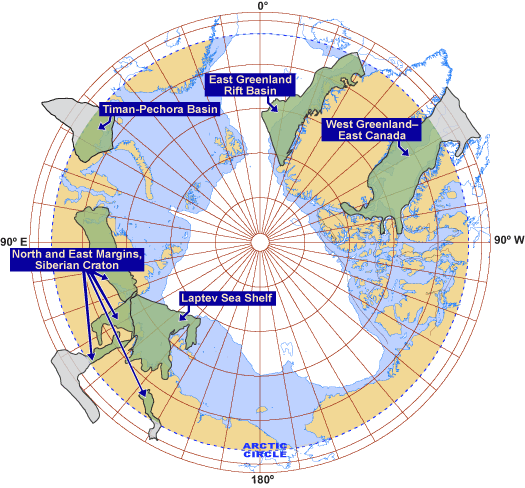Map: Circum-Arctic Resource Appraisal: Estimates of Undiscovered Oil and Gas North of the Arctic Circle. United States Geological Survey. Via Wikimedia Commons.
As climate change rips away the icy armor of the Arctic, nations surrounding the North Pole and companies eager to exploit the area’s mineral wealth–particularly oil and natural gas–are growing giddy with anticipation.
So reports the Associated Press, though the AP is by no means the first to report this story. The slow-motion battle over the increasingly accessible resources of the Arctic is certainly a story. But the prevailing version of that story lacks the proper context, one that is hard to provide since the implications of global climate change are vast and difficult to grasp.
First and foremost, burning additional oil and natural gas made available by receding Arctic ice is nothing short of insane. But in a world that believes that adapting to climate change is merely an engineering problem, this type of talk persists.
Readers of the AP piece are told that those wishing to exploit the Arctic will have to build the necessary infrastructure to service the mining, fishing and tourism interests that want a piece of these boreal riches. (Yes, you read that right: tourism!)
But if development of the Arctic proceeds, it will be a sign that we are doing far too little to abate the very causes of warming that make such development thinkable. That would imply increasingly rapid climate change, something that will almost surely destabilize a world which wants to exploit the Arctic.
In a world plagued with agricultural areas devastated by flood and drought, coastal cities drenched by rising seas, mass migrations from newly uninhabitable areas, spreading tropical diseases, water shortages, and unimaginably long periods of intense summer heat, it is hard to imagine that nations and private companies will be able to provide the systematic focus on Arctic development needed to extract its wealth.
In short, the exploitation of the Arctic implies stability elsewhere; but a continuous rise in Arctic temperatures which will make such exploitation increasingly feasible implies the opposite.
We as a global society cannot seem to see the world in any other frame than that of imperial expansion with the Arctic as the next land to conquer–no matter what. (Outer space also continues to occupy our fantasies as a “next land to conquer.”)
The unfreezing of the Arctic may itself be one of the most dangerous drivers of climate change. The ice–which has prevented those currently salivating over Arctic riches from getting at them–not only keeps the Earth cool by reflecting light back into space; it also keeps untold gigatons of methane sequestered in the tundra and deep ocean. Once in the atmosphere methane traps far more heat than carbon dioxide.
Geologic history suggests that it is possible that a methane release from a melting Arctic would be non-linear (read: sudden and big). Such an event is often referred to as a methane burp. In the geologic past methane burps have been broadly fatal to all things living and may have led to one of the world’s six great extinction events. (The sixth extinction is currently in progress without so far the benefit of a methane burp.)
It turns out that what development of the Arctic implies is so catastrophic that it is hard to understand why we are even discussing it. I am reminded of an old New Yorker magazine cartoon depicting a speaker at a business conference concluding his talk as follows: “And so, while the end-of-the-world scenario will be rife with unimaginable horrors, we believe that the pre-end period will be filled with unprecedented opportunities for profit.”
Most people don’t really understand that a melted Arctic will almost certainly accompany the end of the world as we know it, both in nature and in society. Any profits gained as a result will be as monstrous as those mentioned in the New Yorker cartoon.






